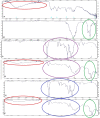Vancomycin Containing PDLLA and PLGA/β-TCP Inhibit Biofilm Formation but Do Not Stimulate Osteogenic Transformation of Human Mesenchymal Stem Cells
- PMID: 35846965
- PMCID: PMC9283789
- DOI: 10.3389/fsurg.2022.885241
Vancomycin Containing PDLLA and PLGA/β-TCP Inhibit Biofilm Formation but Do Not Stimulate Osteogenic Transformation of Human Mesenchymal Stem Cells
Abstract
Aims: Chronic osteomyelitis, including implant-related prosthetic joint infection, is extremely difficult to cure. We develop vancomycin containing release systems from poly(d,l-lactide) (PDLLA) and poly(d,l-lactide-co-glycolide) (PLGA) composites with beta-tricalcium phosphate (β-TCP) to treat methicillin-resistant Staphylococcus aureus osteomyelitis. We ask whether vancomycin containing PDLLA/β-TCP and PLGA/β-TCP composites will prevent early biofilm formation, allow cell proliferation and osteogenic differentiation, and stimulate osteogenic signaling molecules in the absence of an osteogenic medium.
Methods: Composites were produced and characterized with scanning electron microscopy. In vitro vancomycin release was assessed for 6 weeks. Biofilm prevention was calculated by crystal violet staining. Human bone marrow-derived mesenchymal stem cells (hBM-MSCs) and osteosarcoma cell (SaOS-2) proliferation and differentiation were assessed with water soluble tetrazolium salt and alkaline phosphatase (ALP) staining. Real-time quantitative polymerase chain reaction defined osteogenic signaling molecules for hBM-MSCs.
Results: Totally, 3.1 ± 0.2 mg and 3.4 ± 0.4 mg vancomycin released from PDLLA/β-TCP and the PLGA/β-TCP composites, respectively, and inhibited early biofilm formation. hBM-MSCs and SaOS-2 cells proliferated on the composites and stimulated ALP activity of cells. Runt-related transcription factor 2 (RUNX2) and SRY-Box transcription Factor 9 (SOX9) expressions were, however, lower with composites when compared with control.
Conclusion: Vancomycin containing PDLLA/β-TCP and PLGA/β-TCP composites inhibited early biofilm formation and proliferated and differentiated hBM-MSCs and SaOS-2 cells, but osteogenesis-related RUNX2 and SOX9 transcription factors were not strongly expressed in the absence of an osteogenic medium for 14 days.
Keywords: PDLLA; PLGA; biofilm; bone signaling molecules; vancomycin; β-TCP.
Copyright © 2022 Kankilic, Bayramli, Korkusuz, Eroglu, Sener, Mutlu and Korkusuz.
Conflict of interest statement
One or more of the authors (BK, EB, PK, and FK) has received funding from the Republic of Turkey Ministry of Science, Industry and Technology SANTEZ Programme Project No: 00817.STZ.2011-1.
Figures







Similar articles
-
[Study on cytotoxicity of three-dimensional printed β-tricalcium phosphate loaded poly (lactide-co-glycolide) anti-tuberculosis drug sustained release microspheres and its effect on osteogenic differentiation of bone marrow mesenchymal stem cells].Zhongguo Xiu Fu Chong Jian Wai Ke Za Zhi. 2018 Sep 1;32(9):1131-1136. doi: 10.7507/1002-1892.201803067. Zhongguo Xiu Fu Chong Jian Wai Ke Za Zhi. 2018. PMID: 30129348 Free PMC article. Chinese.
-
Vancomycin containing PLLA/β-TCP controls MRSA in vitro.Clin Orthop Relat Res. 2011 Nov;469(11):3222-8. doi: 10.1007/s11999-011-2082-9. Epub 2011 Sep 15. Clin Orthop Relat Res. 2011. PMID: 21918801 Free PMC article.
-
β-TCP from 3D-printed composite scaffolds acts as an effective phosphate source during osteogenic differentiation of human mesenchymal stromal cells.Front Cell Dev Biol. 2023 Oct 26;11:1258161. doi: 10.3389/fcell.2023.1258161. eCollection 2023. Front Cell Dev Biol. 2023. PMID: 37965582 Free PMC article.
-
Antibiotic-loaded hydroxyapatite scaffolds fabricated from Nile tilapia bones for orthopaedics.Int J Pharm X. 2023 Feb 8;5:100169. doi: 10.1016/j.ijpx.2023.100169. eCollection 2023 Dec. Int J Pharm X. 2023. PMID: 36861068 Free PMC article.
-
In vitro proliferation and osteogenic differentiation of human bone marrow-derived mesenchymal stem cells cultured with hardystonite (Ca2ZnSi 2O7) and {beta}-TCP ceramics.J Biomater Appl. 2010 Jul;25(1):39-56. doi: 10.1177/0885328209342469. Epub 2009 Sep 2. J Biomater Appl. 2010. PMID: 19726532
Cited by
-
Cholesterol-Bearing Polysaccharide-Based Nanogels for Development of Novel Immunotherapy and Regenerative Medicine.Gels. 2024 Mar 18;10(3):206. doi: 10.3390/gels10030206. Gels. 2024. PMID: 38534624 Free PMC article. Review.
-
Bioresorbable Polyester Coatings with Antifouling and Antimicrobial Properties for Prevention of Biofilm Formation in Early Stage Infections on Ti6Al4V Hard-Tissue Implants.ACS Appl Bio Mater. 2024 Aug 19;7(8):5728-5739. doi: 10.1021/acsabm.4c00832. Epub 2024 Jul 22. ACS Appl Bio Mater. 2024. PMID: 39037897 Free PMC article.
-
Vancomycin-encapsulated hydrogel loaded microarc-oxidized 3D-printed porous Ti6Al4V implant for infected bone defects: Reconstruction, anti-infection, and osseointegration.Bioact Mater. 2024 Aug 21;42:18-31. doi: 10.1016/j.bioactmat.2024.07.035. eCollection 2024 Dec. Bioact Mater. 2024. PMID: 39262845 Free PMC article.
-
Recent advances in nanostructured delivery systems for vancomycin.Nanomedicine (Lond). 2024;19(23):1931-1951. doi: 10.1080/17435889.2024.2377063. Epub 2024 Aug 15. Nanomedicine (Lond). 2024. PMID: 39143926 Free PMC article. Review.
References
LinkOut - more resources
Full Text Sources
Research Materials

